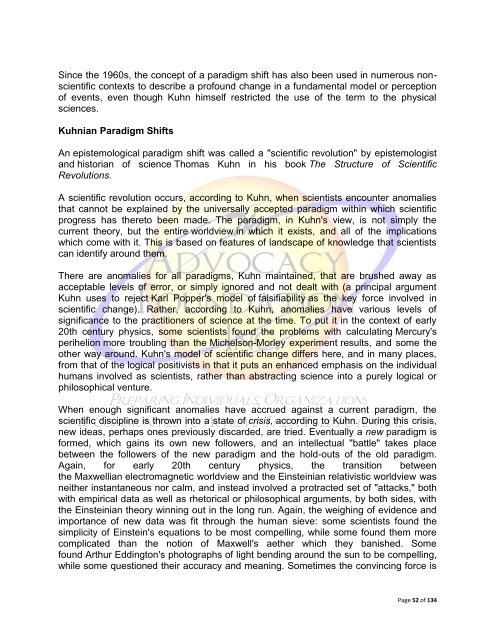Cultural Transformation
Cultural Transformation
Cultural Transformation
You also want an ePaper? Increase the reach of your titles
YUMPU automatically turns print PDFs into web optimized ePapers that Google loves.
Since the 1960s, the concept of a paradigm shift has also been used in numerous nonscientific<br />
contexts to describe a profound change in a fundamental model or perception<br />
of events, even though Kuhn himself restricted the use of the term to the physical<br />
sciences.<br />
Kuhnian Paradigm Shifts<br />
An epistemological paradigm shift was called a "scientific revolution" by epistemologist<br />
and historian of science Thomas Kuhn in his book The Structure of Scientific<br />
Revolutions.<br />
A scientific revolution occurs, according to Kuhn, when scientists encounter anomalies<br />
that cannot be explained by the universally accepted paradigm within which scientific<br />
progress has thereto been made. The paradigm, in Kuhn's view, is not simply the<br />
current theory, but the entire worldview in which it exists, and all of the implications<br />
which come with it. This is based on features of landscape of knowledge that scientists<br />
can identify around them.<br />
There are anomalies for all paradigms, Kuhn maintained, that are brushed away as<br />
acceptable levels of error, or simply ignored and not dealt with (a principal argument<br />
Kuhn uses to reject Karl Popper's model of falsifiability as the key force involved in<br />
scientific change). Rather, according to Kuhn, anomalies have various levels of<br />
significance to the practitioners of science at the time. To put it in the context of early<br />
20th century physics, some scientists found the problems with calculating Mercury's<br />
perihelion more troubling than the Michelson-Morley experiment results, and some the<br />
other way around. Kuhn's model of scientific change differs here, and in many places,<br />
from that of the logical positivists in that it puts an enhanced emphasis on the individual<br />
humans involved as scientists, rather than abstracting science into a purely logical or<br />
philosophical venture.<br />
When enough significant anomalies have accrued against a current paradigm, the<br />
scientific discipline is thrown into a state of crisis, according to Kuhn. During this crisis,<br />
new ideas, perhaps ones previously discarded, are tried. Eventually a new paradigm is<br />
formed, which gains its own new followers, and an intellectual "battle" takes place<br />
between the followers of the new paradigm and the hold-outs of the old paradigm.<br />
Again, for early 20th century physics, the transition between<br />
the Maxwellian electromagnetic worldview and the Einsteinian relativistic worldview was<br />
neither instantaneous nor calm, and instead involved a protracted set of "attacks," both<br />
with empirical data as well as rhetorical or philosophical arguments, by both sides, with<br />
the Einsteinian theory winning out in the long run. Again, the weighing of evidence and<br />
importance of new data was fit through the human sieve: some scientists found the<br />
simplicity of Einstein's equations to be most compelling, while some found them more<br />
complicated than the notion of Maxwell's aether which they banished. Some<br />
found Arthur Eddington's photographs of light bending around the sun to be compelling,<br />
while some questioned their accuracy and meaning. Sometimes the convincing force is<br />
Page 52 of 134

















